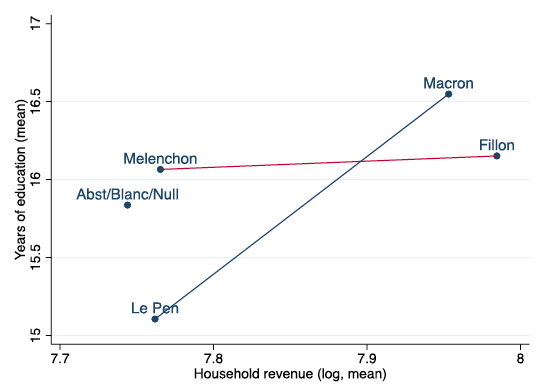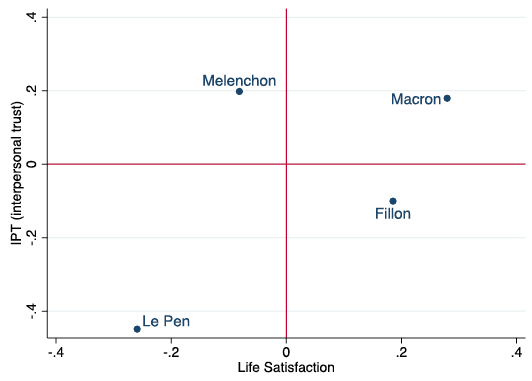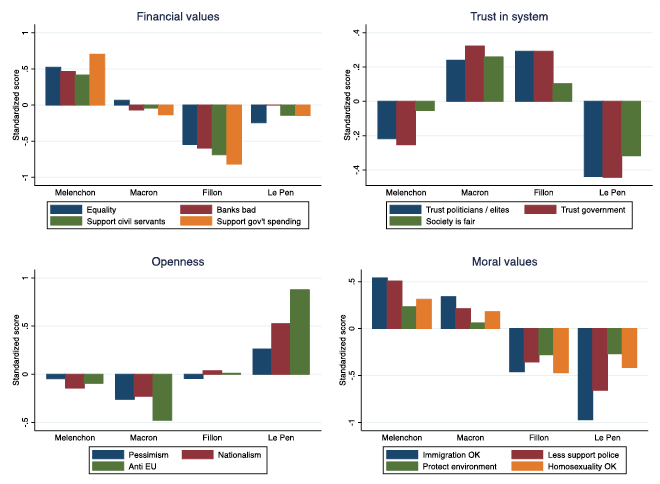From Brexit to the election of Donald Trump, populist parties have gained momentum in many western and European countries (Dustmann et al. 2017), including Poland, Hungary, Switzerland, Denmark, Austria, Finland, France, Italy, and Germany. This progression culminated with Marine Le Pen reaching the second round of the French presidential election in 2017 and the populist governmental coalition in Italy in 2018.1
The French presidential election of 2017, in particular, illustrates the collapse of the traditional left-right political axis, which had been alive and well since the end of WWII. In every presidential election up until 2012, with the exception of 2002, French voters eventually had the choice, in the second round, between a left-wing candidate and a right-wing candidate. In 2017, however, François Fillon, came third in the first round, while the leader of the left, with more radical clothes, Jean-luc Mélenchon, came fourth.The second round was a contest between Emmanuel Macron (whose motto was “neither right or left”) and Marine Le Pen (leader of the extreme right party, Front National). Macron won by a comfortable margin (with 66% of the votes), but the French political landscape had radically changed.
In order to analyse this new political space, in a recent paper we use a unique dataset collected by Cevipof at Sciences Po. Monthly questionnaires were given to around 17,000 panellists from November 2015 up to the 2017 election (Algan et al. 2018). The size and scope of this dataset allows us to examine vote choice in a way that has previously not been possible. It includes socioeconomic variables, geographic localisation, life history, and a wide range of subjective information such as life satisfaction, interpersonal trust, trust towards institutions, and various dimensions of ideology.
A changing map of political choice
In a standard voter choice model, there is a single left-right axis which is principally concerned with redistributive issues. The left – the party of the poor – seeks more redistribution, and the right – the party of the rich – less. The median voter strikes a balance between the two. Yet real-world politics, as demonstrated by the 2017 election in France, shows that voter choice does not work like that anymore (if it ever did). One reason for this is that relatively poor voters do not always seek redistribution, and relatively rich voters do not always oppose it. Le Pen voters (on the extreme right) are, on average, as poor as Mélenchon voters (on the radical left), but according to their answers to the Cevipof survey, they do not seek redistribution to the same degree that Mélenchon voters do.2 Symmetrically, Macron voters are, on average, as rich as Fillon voters (on the conservative right), yet they do not appear to be as hostile to redistribution.
Education could be the main driver explaining the defection of some voters from their financial interest. Education and income are obviously correlated, related by the classic Mincer curve. Someone who is not on this curve is earning either more or less than might be expected given their level of education. Interestingly, the two groups where this discrepancy is largest are those pertaining to the old left-right axis (see Figure 1). Mélenchon and Fillon voters have, on average, similar levels of education, but Mélenchon voters have lower income than predicted by their education and strongly support redistribution. Fillon voters, on the other hand, have higher than expected income conditional on their education and generally oppose redistribution. There is a particular feeling of unfairness on the part of Mélenchon voters that leads them to seek redistribution – they are earning less than they feel that they should, given their level of education. It is exactly the opposite for Fillon voters.
Figure 1 Mean income and education
Notes: Weighted average of education and income for voters of each candidate in the first round in 2012 (left) and 2017 (right). Years of education are estimated from reported diploma, and results are robust to alternative specifications for the education variable. Abst/Blanc/null are those who either did not vote, or whose vote was unvalid.
Le Pen and Macron voters instead have income that is close to what would be expected given their level of education. Both of these groups lack strong preferences about redistribution. Why do the poor Le Pen voters not see that it would be in their interest to raise taxation, and the rich Macron voters see that it would be in their interest to decrease it? This is the critical puzzle that we now investigate.3
Life satisfaction and interpersonal trust
We use life satisfaction and inter-personal trust (referring to trust in people, not in institutions) to explain the dislocation from the right-left axis and why some voters do not support redistributive politics that would benefit them.
Figure 2 Inter-personal trust and life satisfaction, by vote choice
Notes: Weighted average of responses for voters for each candidate in the first round in 2017 for inter personal trust IPT (y-axis) and life satisfaction (x-axis). Both are normalised with mean 0 and standard deviation 1.
Life satisfaction separates the electorate into two groups, and inter-personal trust separates these groups into two more groups.4 Le Pen voters and Mélenchon voters, on average, are the least satisfied with their lives, while Macron and Fillon voters, on average, are the most satisfied. Inter-personal trust separates the electorate along a horizontal axis: Macron and Mélenchon voters share a high level of inter-personal trust, Fillon voters have a lower level, and Le Pen voters have extremely low levels.
These subjective variables map onto both ideology and voter choice: voters with low life satisfaction are anti-system and support radical left- and right-wing populists, and voters with low inter-personal trust are sceptical of the social contract. Since they have high inter-personal trust, Mélenchon voters believe in social justice and favour redistribution. The opposite is true for Le Pen voters – they do not believe that redistribution can work as a solution, even if they could benefit from it in principle. Since they have low inter-personal trust, they are sceptical of the social contract, and they feel that other people, but not them, would benefit from redistributive policies. Macron voters are the opposite of Le Pen voters on both dimensions: with a high inter-personal trust, they are not opposed, in principle, to a redistributive system; they think it might work, if it were needed. But, being rich and satisfied with their lives, they don’t think it is needed after all. The effects pull against each other, and so they are largely indifferent to redistribution. Finally, completing the system, Fillon voters have high life satisfaction (so they do not believe redistribution is necessary) and low inter-personal trust (so they believe it would not work, even if it were necessary).
Life satisfaction and inter-personal trust can be linked to both individual and social variables. Life satisfaction is more closely related to individual socioeconomic characteristics, in particular, income. Inter-personal trust is explained by factors that are fixed relatively early in life: the professional class of parents, and especially the question of whether one is more or less successful than they were, and the culture of the place where one grew up. Le Bras and Todd (2013) use detailed historical data to demonstrate that regional historical differences in France are highly correlated to the vote in favour of Le Pen. In particular, in the southwest of France where extended families have a tradition of working together to build local institutions, inter-personal trust is high and the vote for Le Pen is low. In the northeast, instead, where nuclear families and individualism prevail, inter-personal trust is low and the vote for Le Pen is high.
Different families of ideology
These sociological and biographical differences are reflected in ideologies. There are four groups of variables that fall in different combinations across voter groups. Moral values, such as acceptance of homosexual lifestyles, largely fall on the traditional right-left axis, where Mélenchon and Macron voters are opposites of Fillon and Le Pen voters. Financial values, such as solidarity and redistribution, as discussed above, are not of great interest to Macron and Le Pen voters but are deeply important to Mélenchon and Fillon voters, but in opposite directions.
Figure 3 Ideological groupings (composite variables) by voter choice
Notes: Weighted average of responses for voters for each candidate in the first round in 2017. The questions used in the composition of each ideology can be found in Table 1 of Algan et al. (2018).
Populism, for example in the form of distrust of elites, shows a separation between Le Pen and Mélenchon voters on one side and Fillon and Macron voters on the other. Finally, openness values, such as being pro-EU, are strongly expressed in opposite directions by Macron and Le Pen voters, but Fillon and Mélenchon voters are relatively indifferent on such issues.
A new declassification?
One possible explanation for the transformation of the traditional right-left axis is the demise of the old class system, and there is some support from the data for this premise. On the traditional left-right axis, Mélenchon voters share a sense of class consciousness, just like their adversaries, the Fillon voters. In both cases, their social and professional class is related to their vote, even when controlling for individual income. Le Pen and Macron voters share a more individualistic outlook, where class and the income of their neighbours are less related to their vote, once their own income is controlled for. One possible explanation for the collapse of the traditional right-left axis is that the gradual breakdown of the French class system and the erosion of traditional social structures has left a number of individuals adrift and disenfranchised, a shift from “classes” to “masses”, to paraphrase Hannah Arendt’s analysis of the rise of totalitarianism in the 1930s.
References
Algan, Y, E Beasley, D Cohen and M Foucault (2018) , “The rise of populism and the collapse of the left-right paradigm: Lessons from the 2017 French presidential election”, CEPR Discussion Paper 13103.
Dustmann, C., Eichengreen, B., Otten, S., Sapir, A., Tabellini, G., & Zoega, G. (2017). Europe's trust deficit: causes and remedies, CEPR Press.
Le Bras, H. and E. Todd (2013). Le Mystere Français. Paris: Le Seuil.
Endnotes
1 In this column we use the term ‘populist’ to characterise the radical right, like the Liga or the National Front. The radical left is equally anti-system but, as we document, does not share the same prejudice against minorities and supports a totally different economic platform.
2 Note that references to voter preferences are obtained from responses to the Cevipof questionnaire, not from policy statements from the candidate. Le Pen’s platform may have contained redistributive policies, but when voters were asked about their preferences, people who voted for her hadmuch weaker preferences for redistribution than those who voted for Mélenchon.
3 A number of papers also address this critical issue; we comment a few of them in our paper.
4 The life satisfaction question is “How satisfied are you with the life you lead?” on a scale of 0-10, and the inter-personal trust (questions are a linear combination of trust questions, including “Generally speaking, would you say that most people can be trusted, or that you can never be too careful when dealing with others?”










